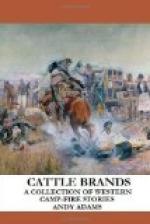“Well, boom if you want,” said Tom Roll, “but do you all remember what the governor of North Carolina said to the governor of South Carolina?”
“It is quite a long time between drinks,” remarked Joe, rising, “but I didn’t want to interrupt Ace.”
As we lined up at the bar, Ace held up a glass two thirds full, and looking at it in a meditative mood, remarked: “Isn’t it funny how little of this stuff it takes to make a fellow feel rich! Why, four bits’ worth under his belt, and the President of the United States can’t hire him.”
As we strolled out into the street, Joe inquired, “Ace, where will I see you after supper?”
“You will see me, not only after supper, but all during supper, sitting right beside you.”
IV
A WINTER ROUND-UP
An hour before daybreak one Christmas morning in the Cherokee Strip, six hundred horses were under saddle awaiting the dawn. It was a clear, frosty morning that bespoke an equally clear day for the wolf rodeo. Every cow-camp within striking distance of the Walnut Grove, on the Salt Fork of the Cimarron, was a scene of activity, taxing to the utmost its hospitality to man and horse. There had been a hearty response to the invitation to attend the circle drive-hunt of this well-known shelter of several bands of gray wolves. The cowmen had suffered so severely in time past from this enemy of cattle that the Cherokee Strip Cattle Association had that year offered a bounty of twenty dollars for wolf scalps.
The lay of the land was extremely favorable. The Walnut Grove was a thickety covert on the north first bottom of the Cimarron, and possibly two miles wide by three long. Across the river, and extending several miles above and below this grove, was the salt plain—an alkali desert which no wild animal, ruminant or carnivorous, would attempt to cross, instinct having warned it of its danger. At the termination of the grove proper, down the river or to the eastward, was a sand dune bottom of several miles, covered by wild plum brush, terminating in a perfect horseshoe a thousand acres in extent, the entrance of which was about a mile wide. After passing the grove, this plum-brush country could be covered by men on horseback, though the chaparral undergrowth of the grove made the use of horses impracticable. The Cimarron River, which surrounds this horseshoe on all sides but the entrance, was probably two hundred yards wide at an average winter stage, deep enough to swim a horse, and cold and rolling.
Across the river, opposite this horseshoe, was a cut-bank twenty feet high in places, with only an occasional cattle trail leading down to the water. This cut-bank formed the second bottom on that side, and the alkaline plain—the first bottom—ended a mile or more up the river. It was an ideal situation for a drive-hunt, and legend, corroborated by evidences, said that the Cherokees, when they used this outlet as a hunting-ground after their enforced emigration from Georgia, had held numerous circle hunts over the same ground after buffalo, deer, and elk.




